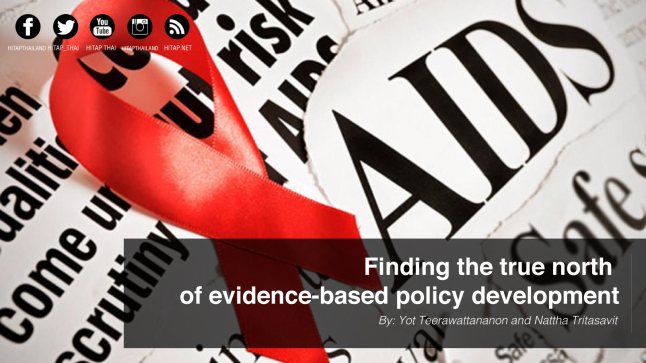Overcoming Barriers: Financing and Service Delivery for Vaccination in Fragile and Conflict-Affected States


Finding true north is important for accurate navigation to embarking on the right path. While there may be many paths to making policy decisions, the ultimate goal is to end up with a decision that has been well-informed by evidence. Evidenced-based policy decisions result in more transparent and effective outcomes that are defendable to the public. A case in point is the expansion of antiretroviral treatment (ART) for HIV/AIDS in Thailand.
Although the Thai Universal Healthcare Coverage (UHC) excluded ART for HIV/AIDS when it was introduced in 2002, it included ART for all eligible patients the following year due to the Prime Minister’s announcement during the World AIDS Conference in Bangkok. Whether this inclusion was based on evidence, careful consideration, or political bravery, it has been considered as another success story by champions for HIV and the story was used to inspire other low- and middle-income countries (LMICs) to follow the path of providing universal access to ART.
Until March 2014, almost 300,000 HIV-infected persons received ART. The current ART guidelines indicate that HIV-infected persons with CD4 lower than 350 cells/mm3 are eligible. This change two years ago in the CD4 threshold from 250 cells/mm3 was the result of a long standing debate between two opposing groups: One opposed the change because they estimated that almost 33,000 patients with CD4 lower than 250 cells/mm3 were not able to access ART due to several reasons, including unknown HIV status. The other supported the change because scientific evidence proved a greater health benefit of HIV patients. The central theme of the debate surrounded the issue of whether Thailand should devote their limited resources to patients who could not access ART by identifying unknown HIV infections versus giving the benefits to those who already knew of their HIV status but did not qualify for the CD4 threshold.
On 31 July 2013, the national AIDS committee approved an ‘end AIDS’ policy, with the ultimate goal of zero mother-to-child HIV transmissions, reducing new HIV infections to less than 1000 persons/year or 10% of the current statistic, and providing ART to all known HIV-infections. A key strategy of this policy is to provide ART regardless of CD4 levels. Although there is no evidence to support the benefit of ART for HIV patients at CD4 above 500 cells/mm3, a study in Africa showed that early ART can reduce HIV transmission. So ART at an early stage is mainly for the benefit of society and perhaps at the cost of the patients’ health due to potential adverse reactions and drug resistance. Surprisingly, there is not much debate at this time, which may be due to the previous painful debate.
The national AIDS committee produced a report indicating that the policy was based on economic evidence, produced by overseas AIDS experts. The evidence suggests that expanding or scaling up ART to all HIV-infected individuals would offer good economic return to the country: spending USD $95 million over 10 years would result in a return of investment amounting to over USD $300 million. In other words, the benefit to cost ratio of the scale up is equivalent to 3:1.
HITAP was requested by the National Health Security Office (NHSO) to assess the feasibility of this policy because the NHSO needs to be responsible for financing major activities of this end AIDS policy. HITAP carefully examined the evidence presented by the AIDS committee and the respective national plan proposed by the public authorities responsible for policy implementation. Two obvious issues arose from the review. First, the report provided an optimistic estimate of the effectiveness of HIV screening, which is a crucial success factor of the end AIDS policy. It suggests that 1 new HIV case would be detected for every 26 screened. This is in contrast to the empirical evidence in Thailand, showing that scaling up HIV screening would significantly increase the number of screenings needed to identify a new HIV case to more than 200. Secondly, the bigger issue is that the report informs us that the USD $95 million needed for the policy is of a net present value (discounting all future investments in the current value of money). This figure was referred to by the AIDS committee and used as an absolute number, saying that the policy needs USD $100 million of investments over 10 years or an additional USD $10 million per annum on top of the current HIV budget. HITAP’s estimation is that if the net present value is converted to an absolute number, the policy will require USD $380 million or an average of USD $38 million per annum.
The review results were presented in a stakeholder consultation meeting last month and created debate about the financial sustainability of this policy and feasibility of devoting human resources for HIV screening and early ART, especially in making asymptomatic patients adhere to the treatment in order to prevent the development of drug resistance in patients with poor ART adherence. Drug resistance would lead to a higher burden of finances and human resources in offering more expensive second-, third-, and fourth-line ART drugs, which is not properly incorporated in the economic analysis.
It remains to be seen how the NHSO will decide on this case, but one thing is certain: this circumstance illustrates the benefits of having evidence-based policy decisions. All decisions are made based on publicly available evidence for all stakeholders to carefully consider and discuss. However, it also shows that making evidence available for policy decisions is not enough. Decision makers and other stakeholders need to be empowered to access and appropriately interpret the available evidence to be able to claim that policy decisions are well-informed by evidence. This showcase is very much in line with the scope of iDSI in which we try to build up local capacity of researchers and decision makers to be able to generate and make use of evidence appropriately, across health problems as opposed to specific diseases or technologies. The process takes time, effort, and compassion but leads to sustainable health development.
More information : www.hitap.net or follow us on Facebook | Twitter